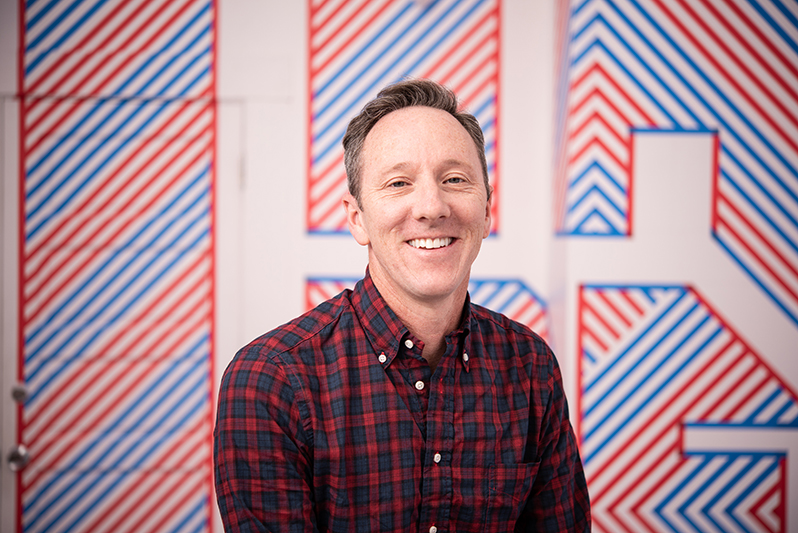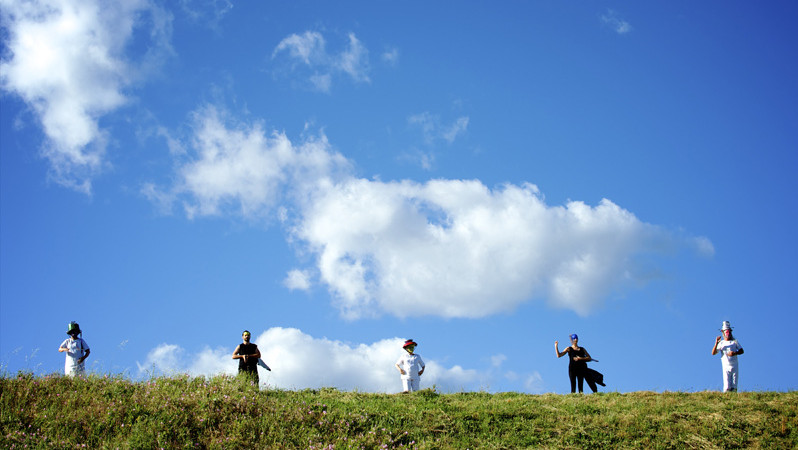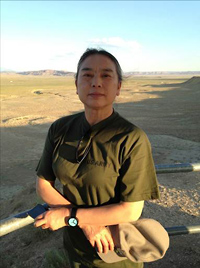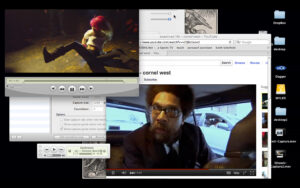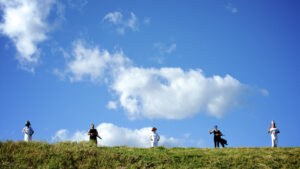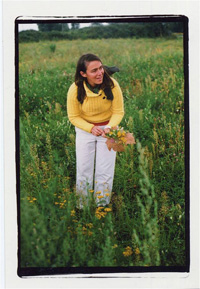Introduction
Over the course of three days in 1965, San Francisco graphic designer Barbara Stauffacher Solomon painted large-scale graphics on the walls of the changing rooms at The Sea Ranch’s Moonraker Athletic Center as a way to inexpensively enliven the space. To many, Solomon’s graphics represent the first significant application of what became known as “supergraphics” as an architectural component. The legacy of supergraphics continues through the work of artists such as Frank Stella and Jan Van Der Ploeg, who paint directly on walls and employ bold graphic design to create work that is architectural in scale and ambition. This project uses colored tape instead of paint to make a big colorful mural that can be quickly produced by a group of students, is adjustable on the fly, and is easily removed.
Media
Tape + A Wall
Materials
Colored masking tape. We like Scotch Expressions and ScotchBlue painter’s tape, but the artist tape widely available at art stores is good, too.
A variety of rulers and straight edges. Long rulers are good for taping straight lines. Short rulers are great to hold down on the tape and tear clean lines, as well as for measuring and marking points. It’s useful to cut a bunch of long (3–4 foot) thin straightedges out of foam core. Put a piece of tape on each end and use them as hands-free guides to tape straight lines, or use them as spacers for creating stripes.
Levels. Long ones make good straightedges, especially while making lines that are perfectly vertical, horizontal, or 45 degrees. Short “torpedo” levels are useful as well.
X-Acto knives. If you can, cut on the wall, but it will leave small marks. Otherwise use your straightedges to rip the tape cleanly.
Measuring tape.
Pencils.
Ladders (if required).
Download This Activity
PDF | Word Document
About Open Studio
Designed by practicing artists, the Open Studio classroom activities aim to connect high school teachers and students with key ideas and issues in contemporary art. See all of the Open Studio activities.
The Project
This project is meant for a group to make collectively. It can be approached so the group works together on one agreed-upon graphic gesture, or subdivided so smaller teams of 2 to 4 people each work on a section.
- Pick your wall. The size of the workspace will determine many decisions.
- Consider what you want on the wall. It could be a word or phrase, some decorative graphics, or a combination.
Decide if you are making one large collective gesture or subdividing the wall into sections. If subdividing, decide how many sections to make. If, for example, you have 18 students and a 30-foot long wall, the wall could be divided vertically into six 5-foot-wide sections, with three students assigned to each.
Some questions you might ask when brainstorming the work:
- Will your supergraphic relate to the specific use of the designated space? For example, if the work is in a gymnasium, does it depict sports equipment or a quote from an athlete?
- Will your supergraphic include text? Imagery? Abstract forms and shapes?
- Will your supergraphic represent the values of the people it is designed by or for?
- Sketch out ideas. Work individually and on paper for a half-hour or so. The point of this is not to create something that will be meticulously repeated on the wall, but to develop ideas as a starting point. It’s both faster and more fun to allow for improvisation while creating the supergraphic itself.
Then come together and look over each other’s sketches. If you are making one large graphic, this is where everyone needs to agree on a direction, and plan it out.
- Frame out the design. Find the wall’s center and, using a level, tape a straight line top to bottom. Then create any subdivisions, also using a level. If writing a word, box out each letter. So if you had that same 30-foot wide wall and you wanted it to say “IMAGINE” you might divide the wall by 9 sections (7 letters + an equal margin on each end), then decide how much spacing you want between each letter.
Run lines horizontally with tape and level to box out the top and baseline of the text. Then figure out how you want one key letter to look, like the “G.” Once the weight and look of that feels right, apply the same angles and dimensions to the other letters.
- Detail your design. Start to fill in the wall with your graphics, framing out large shapes and then adding stripes, solid fills, dots, patterns, and other graphics with the tape. This is where things start to get fun and improvisational. If something doesn’t look good, pull it off and try another approach.
As you trim out the original boxes, guidelines, and excess lines, be conscious of your tape “craft”—keep lines straight and tears clean, so that the work feels considered and refined.
Keep going until the design is finished—either when you complete your proposed design, or, if winging it, when you run out of time. Touch up any tape gaps or other elements that need adjustment.
7. Stand back and admire your supergraphic!
